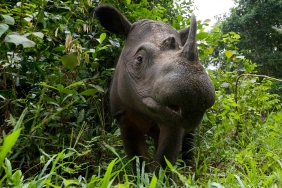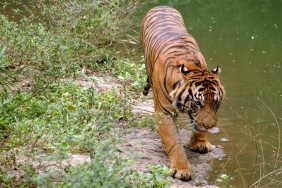WWF CALLS FOR MULTI-STAKEHOLDER PARTICIPATION TO SUPPORT ORANGUTAN CONSERVATION IN BORNEO
Jakarta, Kuching and Sarawak - Coinciding with International Orangutan Day on August 19, WWF-Indonesia and WWF Malaysia invite stakeholders including the business sector to participate in strengthening Bornean orangutan conservation, especially in the border area between Indonesia and Malaysia.
The Transboundary Orangutan Action Plan that was initiated by the Forestry Department of Sarawak State, Malaysia, in 2005, is very relevant to be strengthened for both countries in the context of better protection for these primates spread across the Heart of Borneo (HoB) region - precisely in Kalimantan and in the Malaysian states of Sabah and Sarawak. It is time for concession holders located in the region to implement orangutan conservation plans as part of their commitment to responsible forestry sector practices.
In his message marking the celebration of International Orangutan Day, WWF-Indonesia CEO, Dr. Efransjah, explained, "Our research shows that 70 percent of the orangutan population in Betung Kerihun National Park, West Kalimantan, is located in a transboundary area, bordering the Lanjak Entimau Nature Reserve in Malaysia. This emphasizes the importance of cooperation between the two countries to work together to save this species."
He continued that in Kalimantan alone, more than 70 percent of orangutans live outside protected areas, for example in company concession areas, so in order for these endangered animals to survive, cooperation with businessmen who own these concessions is very important.
"WWF-Indonesia has been working with several concessionaires in Kalimantan to help protect orangutans in their areas by integrating timber production management plans with wildlife conservation, in this case orangutans. These concessions cover 300,000 hectares or more than a third of the orangutan priority areas in the Arut Belantikan orangutan landscape in Kalimantan," he said.
Through WWF facilitation, one of the concession companies, PT Suka Jaya Makmur (SJM), located in Ketapang Regency, West Kalimantan, has successfully developed and implemented a production forest management plan that synergizes with orangutan conservation, and because of its success, the company received FSC certification, a globally accepted certification. PT SJM is the first company in Indonesia to develop orangutan management under this concept and achieve the highest standard of sustainability practices.
WWF's research shows that as long as logging is done in a sustainable way, natural orangutan food is kept available, and the threat of hunting is strictly controlled, orangutans can live well in production forests.
In general, CITES categorizes the Bornean orangutan (Pongo pygmaues) as a threatened species (Appendix I). Orangutan populations are threatened by habitat fragmentation of approximately 55% in the last 20 years due to forest conversion for plantations, mining and settlements. The great ape population is also threatened by forest fires and the pet trade.
The Chairman of Indonesia's HoB National Working Group, Dr. Prabianto Mukti Wibowo, said that the Indonesian Government is committed to conservation and sustainable development in the HoB. To guarantee the achievement of the HoB vision, including addressing deforestation and supporting biodiversity conservation, he further said that it is important to improve the condition of critical deforested forests and to ensure the connectivity of wildlife biodiversity corridors, while at the same time also promoting sustainable forest management, both in the sustainable timber and palm oil production sectors. Therefore, the participation of the private sector and local communities in the area is a major factor. ""This vision will demonstrate a tangible implementation of the green economy concept, where businesses can operate without harming endangered species,"" he said.
The island of Borneo is unique in that it has three sub-species of orangutan: Pongo pygmaeus pygmaeus (northwest population), Pongo pygmaeus morio (northeast population) and Pongo pygmaeus wurmbii (southwest population). In 2004, there were an estimated 54,000 orangutans on the island of Borneo, divided between the lowland tropical rainforests of Indonesia and Malaysia.
WWF-Malaysia CEO, Dato'Dr. Dionysius Sharma, revealed, "To achieve the orangutan management plan, it is necessary to develop ecological connections to monitor orangutan movements and secure good forest conditions in the HoB region." For example, he explained, the ecological connectivity between Batang Ai National Park and Lanjak Entimau Nature Reserve, in Sarawak with Betung Kerihun National Park in Kalimantan and adjacent concession areas is an important conservation area. "We call on concession companies to implement Orangutan Action Plans in Transboundary Areas where orangutan habitats exist adjacent to their concession areas," he continued. He also emphasized that good management of orangutans will benefit the community, including the protection of other flora and fauna in the area.
Director of the Sarawak State Forestry Department, Sapuan Ahmad, said research is still being conducted by various organizations on orangutans and other species in the HoB and surrounding areas. "Our main concerns are on sustainable forest management, cultural, adventure and nature-based ecotourism, biodiversity conservation, sustainable agriculture and land use and rural poverty alleviation programs."" Given the importance of the area, he added that the Sarawak Government will monitor all programs undertaken to ensure that these plans are in line with sustainable development and habitat conservation policies.
WWF-Malaysia applauded the integrated conservation efforts made by the Sabah State Government that returned orangutans to their habitat in the wild. Sabah State Forestry Department Director, Datuk Sam Mannan, said that together with WWF-Malaysia, they have been reforesting about 2,400 hectares of degraded orangutan habitat in the Bukit Piton Protection Forest since 2005. Due to past illegal logging and forest fires, Bukit Piton Protection Forest is a critical status area with a small orangutan population estimated at around 170-300 individuals in 2007 and 2008. However, restoration work is showing a positive impact as several orangutan nests have been found.
"Orangutan surveys in Ulu Segama Utara, Malua and Sungai Bole have provided input and strengthened research data for the development of a wildlife corridor between Malua-Deramakot and Ulu Kalumpang-Ulu Segama, the Heart of Borneo HoB, which is an important orangutan habitat," he explained.
Note to Editor:
- High-resolution photos related to orangutans can be downloaded from http://bit.ly/1mPtY2H, and used with WWF's copyright.
- Video on orangutan conservation in a natural forest concession area in Ketapang, West Kalimantan: http://bit.ly/1l85Opf
- Video on orangutans, logging and their habitat in Bukit Piton Protection Forest, Malaysia: http://bit.ly/VpbwGN
For more information, please contact:
- Nyoman Iswarayoga, Director of Communications and Advocacy, WWF-Indonesia (niswarayoga@wwf.or.id, +62 811 1284868+62 811 1284868)
- Albertus Tiju, Project Leader Kapuas Hulu - West Kalimantan, WWF-Indonesia(Albertus@wwf.or.id, Phone: +62 812 5624019+62 812 5624019)
Call
Send SMS
Add to Skype
You'll need Skype CreditFree via Skype





